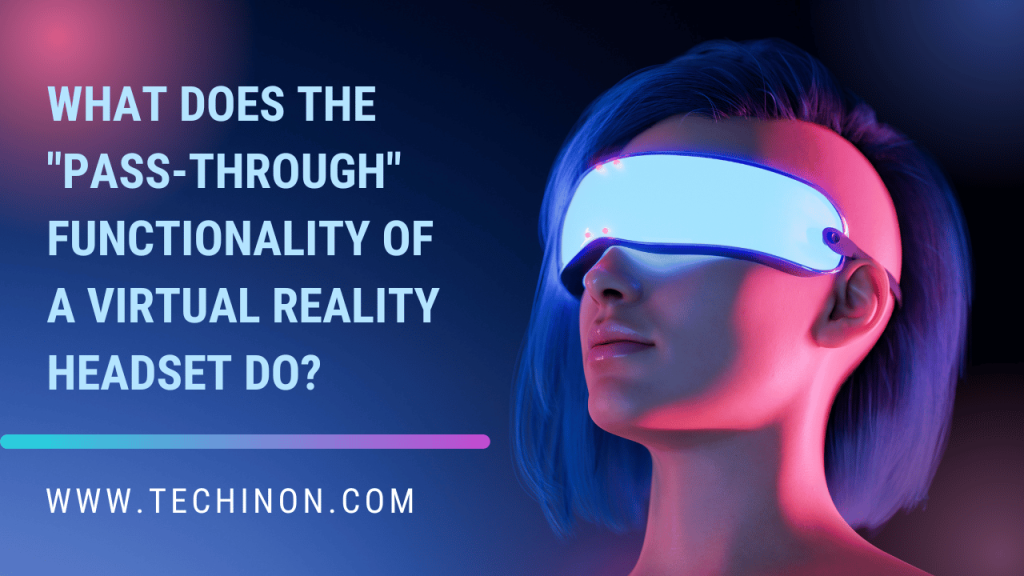Virtual reality (VR) technology has transformed the way we interact with digital content. One of its breakthrough features is the “pass-through” functionality, a powerful tool that blurs the lines between our physical world and the immersive digital universe. Keep reading to understand the topic “What Does the “Pass-Through” Functionality of a Virtual Reality Headset do?”.
What is Pass-through in a Virtual Reality Headset?
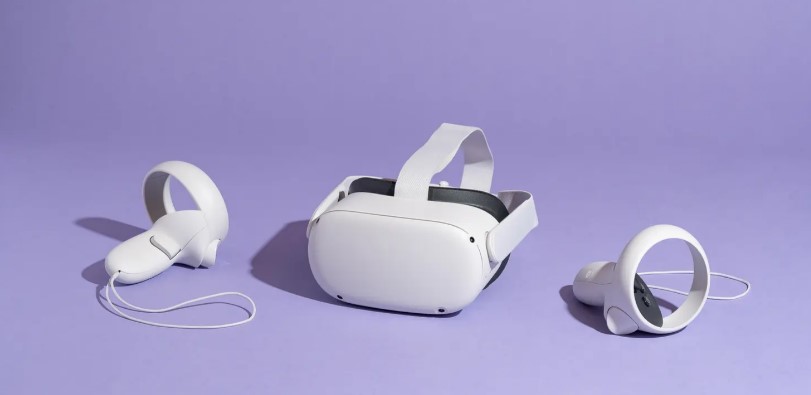
The pass-through feature in a VR headset enables users to view the real world without removing the device. It’s like a window that opens up to your physical environment, granting you the power to interact with the real world while immersed in a virtual one. This feature leverages the built-in cameras on the headset to feed real-time video of your surroundings directly to your display.
Imagine needing a drink of water during an intense VR gaming session. Instead of pausing the game and removing your headset, you can simply switch to pass-through mode and navigate to your kitchen safely and comfortably!
How Does Pass-through Work on a Virtual Reality Headset?
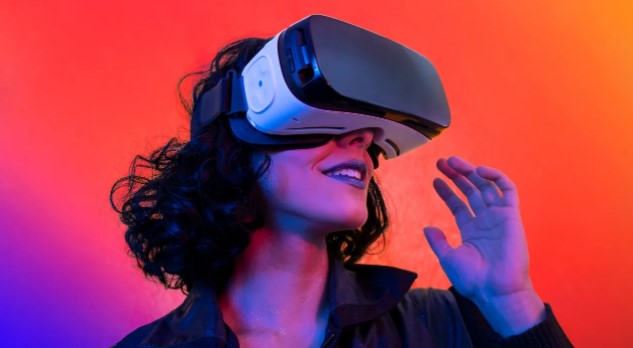
Passthrough technology relies heavily on the headset’s integrated cameras and advanced software algorithms. These cameras capture your real-world view, and software processes this data to present a clear and precise representation of your environment on your headset display.
Alongside real-time video feed, innovative technologies like simultaneous localization and mapping (SLAM) and environmental understanding algorithms work together to build a digital map of your surroundings. These advancements ensure accurate depth perception and spatial awareness, vital for seamless navigation and interaction in passthrough mode.
What are the Benefits of Using the Pass-through Feature in VR?
The pass-through function opens a realm of possibilities, enhancing the VR experience in countless ways.
Safety First
With passthrough enabled, you can see your real-world environment and avoid potential hazards. No more bumping into furniture or stepping on your pet’s tail during a virtual quest!
Enhanced Immersion
By blending the real and the virtual worlds, the passthrough feature can enrich the immersive experience. It can transform your living room into an alien spaceship or your backyard into an enchanted forest.
Convenience
Need to pick up a call, check the time, or grab a snack? With pass-through, you don’t need to hit pause or remove your headset.
Which VR Headsets have Pass-through Capabilities?
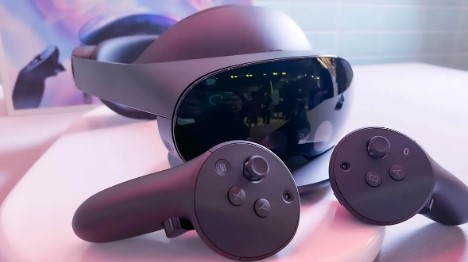
Many modern VR headsets offer pass-through features. For instance, Oculus Rift S, Oculus Quest, and the HTC Vive Pro series come equipped with robust passthrough capabilities. It’s always worth checking the specifications or contacting the manufacturer to ensure your chosen headset supports this feature.
Can I Interact with the Real World while in Virtual Reality using Pass-through?
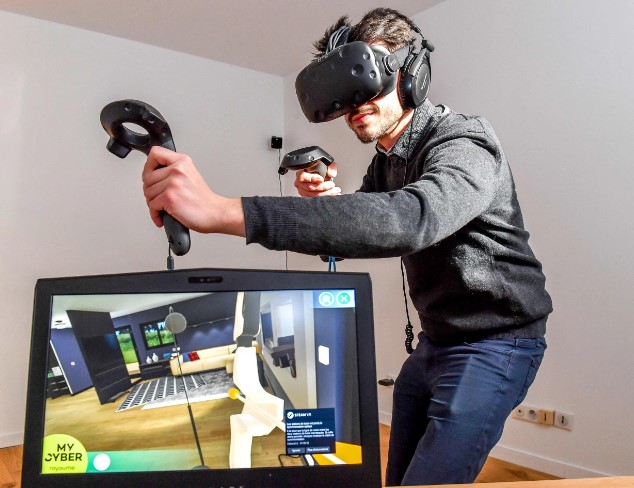
Yes, the passthrough feature allows you to interact with your physical environment while remaining immersed in VR. You can reach out for objects, move around, and even complete tasks without the need to remove your headset. This seamless integration of realities can revolutionize applications beyond gaming, including education, training, and professional workspaces.
Are there any Limitations or Drawbacks to Using Pass-through in VR?
While the pass-through feature enhances VR experiences, it isn’t perfect. The resolution and quality of the real-world view can sometimes be lower than the immersive VR content. There might be discrepancies in depth perception and occasional latency in image display. However, advancements in VR technology are steadily addressing these limitations.
Does Pass-through Affect the Virtual Reality Experience?
Rather than diminishing the VR experience, pass-through augments it. It ensures safety, adds convenience, and can potentially enhance immersion. It’s a gateway that bridges the gap between our physical world and the virtual landscapes we explore.
Can Pass-through be used for Augmented Reality Experiences?
Yes, the passthrough feature plays a vital role in augmented reality (AR) experiences. It enables AR applications tooverlay digital information onto the real-world view. This technology powers various applications from gaming, like Pokémon Go, to practical uses, such as IKEA’s app that lets you virtually ‘place’ furniture in your room.
Is Pass-through Useful for Gaming or Only for Specific Applications?
While pass-through technology has widespread applications in professional and educational contexts, it is also exceptionally useful in gaming. This feature can enhance user safety, provide convenience, and potentially create novel gaming experiences by integrating real-world elements into the game environment.
Can I Customize the Level of Transparency in Pass-through Mode?
Customizability of the pass-through feature, such as adjusting the level of transparency, depends on the specific VR headset model and the supporting software. Some VR systems allow users to customize their experience, offering a tailored blend of reality and virtual content.
Are There Any Privacy Concerns Related to the Pass-through Functionality?
Privacy concerns can arise since pass-through functionality relies on the VR headset’s cameras, which capture the user’s environment. However, most VR companies commit to user privacy by processing the camera data locally on the device and not storing or transmitting this information. It’s crucial to read the privacy policy of the VR headset manufacturer to understand how they handle your data.
How is the Pass-through Video Captured in VR Headsets?
In VR headsets, the pass-through video is captured using integrated cameras, typically mounted on the outside of the headset. These cameras are essentially the headset’s ‘eyes,’ capturing the external environment and feeding the information back to the user.
The operation of these cameras varies among different VR headsets. Some devices use monochrome cameras, while others utilize full-color sensors. The images captured by these cameras are then processed by the headset’s onboard software to generate a real-time display that users see when they switch to pass-through mode.
Deep Dive: Technological Marvels behind Pass-through
One of the critical technologies enabling the pass-through feature is simultaneous localization and mapping, commonly known as SLAM. It’s a computational problem of constructing or updating a map of an unknown environment while simultaneously keeping track of an agent’s location within it.
In the context of VR, SLAM is used to understand the physical space around the user. It enables the headset to create a digital map of the real world, allowing users to navigate their physical environment safely while wearing the VR headset in pass-through mode.
Another technological marvel that makes pass-through possible is environmental understanding. This capability enables the VR system to recognize and interpret objects, structures, and spaces in the user’s environment. It’s what allows your VR headset to differentiate between a wall and a chair or understand the layout of a room.
Beyond Gaming: Real-world Applications of Pass-through VR
The integration of real and virtual worlds through the pass-through feature can revolutionize numerous sectors beyond gaming.
Education and Training: By combining VR and real-world elements, educators can create more immersive and interactive learning experiences. For example, medical students can practice surgeries in a virtual operating room while still being able to interact with real-world instruments.
Architecture and Design: Professionals can overlay their designs onto the physical world, allowing them to visualize and modify their projects in real-time. Architects, for instance, can walk through a virtual building superimposed on a real construction site.
Remote Collaboration: Workplaces can use pass-through VR for meetings and collaborative projects. Colleagues can interact in a virtual shared space, visualize data, brainstorm ideas, and even manipulate digital objects, all while being aware of their physical surroundings.
Must Read: Bail Money Loans in Rowland Heights CA
Future Trends in Pass-through Technology
As the field of virtual reality continues to evolve, pass-through technology is poised for significant advancements. Future trends may include:
Improved Visual Quality: Companies are consistently working on improving the resolution and quality of the pass-through video. The goal is to achieve a visual experience that is as close to natural human vision as possible.
More Accurate Depth Perception: Future developments aim to enhance depth perception in pass-through mode, which will make interacting with the physical environment while wearing a VR headset more natural and intuitive.
Smarter Environmental Understanding: Advancements in artificial intelligence (AI) will enhance the VR system’s understanding of the user’s environment, making the pass-through experience smoother and more immersive.
AR/VR Fusion: As pass-through technology improves, the line between VR and augmented reality (AR) will continue to blur. This fusion could lead to ‘mixed reality’ headsets that offer the best of both worlds, allowing users to switch seamlessly between full immersion and augmented experiences.
The pass-through functionality in VR headsets is more than a fancy feature; it’s a glimpse into the future of digital interaction. As this technology continues to advance, the boundaries between our physical world and virtual realities will become ever more intertwined, leading us to uncharted territories of digital exploration. The magic of VR pass-through is just beginning – buckle up for the journey!
Also Read: What Describes the Relationship Between Edge Computing and Cloud Computing?
Conclusion: The Revolutionary Pass-through Feature in VR Headsets
The pass-through functionality in VR headsets represents a significant leap in virtual reality technology. By allowing users to view and interact with the real world without removing their headsets, VR pass-through has the potential to revolutionize how we consume digital content.
From enhanced safety and convenience to innovative gaming experiences and augmented reality applications, the pass-through feature continues to push the boundaries of what’s possible in the world of virtual reality. As VR technology continues to evolve, we can expect even more exciting advancements in pass-through functionality that will further blur the lines between our physical and virtual worlds.
Whether you’re a gamer, an educator, or a professional, the VR pass-through feature offers an impressive toolset to enhance your immersive experiences. Now is an exciting time to explore these emerging capabilities, and there’s no doubt that the future holds even more promise for this fascinating technology.
So, Dive in, and explore “What Does the “Pass-Through” Functionality of a Virtual Reality Headset do?”.
Iva Ort is an ingenious wordsmith and captivating blogger whose tales leap off the screen and into your imagination. With a pen as her wand, she weaves enchanting stories and insightful articles, leaving readers spellbound and craving more.

